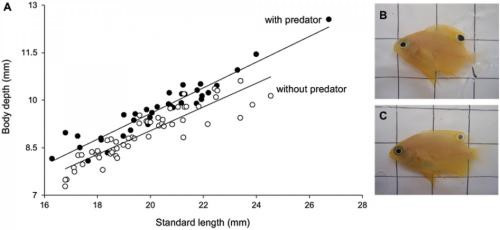Damselfish Grow Fake Eyes To Trick Predators, ‘Amazing Feat Of Cunning’ For Tiny Fish [PHOTO]

They may be small, but tiny prey fish have a big way of protecting themselves from predators.
A new study reveals that small damselfish grow false eye spots on their rear fins while reducing the size of their real eyes to distract predatory fish from gobbling them up, Oona Lönnstedt, a graduate student at Australia’s ARC Centre of Excellence for Coral Reef Studies said in a statement.
“It’s an amazing feat of cunning for a tiny fish,” Lönnstedt said. “We found that when young damsel fish were placed in a specially built tank where they could see and smell predatory fish without being attacked, they automatically began to grow a bigger eye spot, and their real eye became relatively smaller, compared with damsels exposed only to herbivorous fish, or isolated ones.”
What predators see is an optical illusion of sorts – where their prey travels in the opposite direction of its actual path.
The study, published in the journal Scientific Reports, is first of its kind to document “predator-induced changes” in the size of eyes and eye-spots on prey animals. And the eye trick works.
Researchers found that young damselfish that grew bigger eyes in face of predators had five times the survival rate of fish with a normal-sized spot on their rear fins. “This was dramatic proof that eyespots work – and give young fish a hugely increased chance of not being eaten,” Lönnstedt said.
The study involved placing damselfish in several tanks in a lab. Using natural predators like the dusky dottybacks and an herbivorous fish called a goby -- some of the fish were exposed to the scent of their predators, others to the goby and to no other fish at all over a period of six weeks.
“We think the eyespots not only cause the predator to attack the wrong end of the fish, enabling it to escape by accelerating in the opposite direction, but also reduce the risk of fatal injury to the head,” Lönnstedt said.
Damselfish are a family of brightly colored fish that live in coral reefs in coast regions in tropical waters. There are about 250 species of damselfish that are found in shades of red, orange, yellow or blue and do not exceed 6 inches in length. The species used in the study, Pomacentrus amboinensis, are typically found in the western Pacific Ocean.
© Copyright IBTimes 2024. All rights reserved.






















